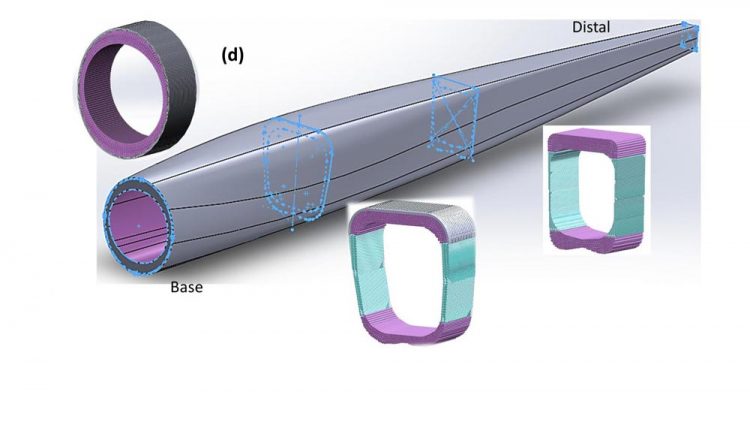Researchers explain why feather shafts change shape when under stress

The feather-shaft cortex is a fibrous composite with varying fiber orientations along the length adjusting to local stress requirements: the increasing amount of axial fibers ensure sufficient flexural rigidity, while the crossed fibers provide reasonable flexibility and torsional rigidity. The features revealed symbolize the unique adaptation of feathers for optimized stiffness and lightness, a natural structure inspiring for advanced engineering designs Credit: UC San Diego
In their study, using fundamental mechanics equations and experiments in modeling materials, researchers show that the square shape provides greater rigidity and higher resistance to ovalization and buckling than a hollow round shape of the same weight.
“The most amazing thing is that this reflects textbook mechanics,” said Marc Meyers, the paper's senior author and a professor of mechanical and aerospace engineering at the Jacobs School of Engineering at UC San Diego. “And obviously, birds haven't studied that subject.”
Ovalization can be observed by subjecting a drink straw to progressive bending: the section will gradually change from round to oval, and the stiffness is correspondingly decreased. But the feathers of flying birds, with a round-to-square sectional shape, retain their rigidity intact in spite of bending.
By contrast, non-flight feathers, such as flightless ostrich wing feathers and peacock tail feathers, are not subjected to the same constraints and their shafts do not change from round to square. This is because a feather is a highly specialized appendage that enables birds to fly, generating thrust and lift. Its mechanical properties are optimized and weight minimized.
The feather-shaft cortex is a fibrous composite with varying fiber orientations along the length adjusting to local stress requirements: the increasing amount of axial fibers ensure sufficient flexural rigidity, while the crossed fibers provide reasonable flexibility and torsional rigidity.
The features revealed symbolize the unique adaptation of feathers for optimized stiffness and lightness, a natural structure inspiring for advanced engineering designs.
“Nature is indeed wondrous,” said Bin Wang, the paper's lead author and a member of Meyers' research group. “And it is such a beauty to look at nature with human knowledge.”
Wang and Meyers said that the findings could be used to build stronger, stiffer square foam-filled structures for lightweight vehicles, such as drones and other aircraft. They also said that the findings could be applied to other types of energy-efficient structures.
Media Contact
All latest news from the category: Power and Electrical Engineering
This topic covers issues related to energy generation, conversion, transportation and consumption and how the industry is addressing the challenge of energy efficiency in general.
innovations-report provides in-depth and informative reports and articles on subjects ranging from wind energy, fuel cell technology, solar energy, geothermal energy, petroleum, gas, nuclear engineering, alternative energy and energy efficiency to fusion, hydrogen and superconductor technologies.
Newest articles

NASA: Mystery of life’s handedness deepens
The mystery of why life uses molecules with specific orientations has deepened with a NASA-funded discovery that RNA — a key molecule thought to have potentially held the instructions for…

What are the effects of historic lithium mining on water quality?
Study reveals low levels of common contaminants but high levels of other elements in waters associated with an abandoned lithium mine. Lithium ore and mining waste from a historic lithium…

Quantum-inspired design boosts efficiency of heat-to-electricity conversion
Rice engineers take unconventional route to improving thermophotovoltaic systems. Researchers at Rice University have found a new way to improve a key element of thermophotovoltaic (TPV) systems, which convert heat…



